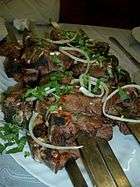Khorovats


Khorovats (Armenian: խորոված, [χoɾoˈvɑt͡s]) is an Armenian barbecue.[1] It is the most representative dish of Armenian cuisine enjoyed in restaurants, family gatherings, and as fast food[2] in Armenia and by Armenians around the world.
Etymology
The word "խորոված" khorovats means "grilled" in Armenian and comes from the verb "խորովել" khorovel (to grill). It can also be spelled Xorovac.
Description
A typical khorovats is made of chunks of meat grilled on a shampoor (շամփուր) or skewer, although steaks or chops grilled without skewers may be also used.
2006 book Armenian Food: Fact, Fiction & Folklore gives three tips for making good khorovats:[3]
- The distance between the fire and the skewers should be approximately 12 to 15 centimeters (about 6 inches)
- The largest pieces of meat should always go in the middle where there is more heat for the fire
- Shampoors (skewers) should be placed close together to concentrate the heat from the cooking fire
In Armenia itself, khorovats is often made with the bone still in the meat (as lamb or pork chops).[2] Western Armenians outside Armenia generally cook the meat with bones taken out and call it by the Turkish name shish kebab. On the other hand, the word kebab in Armenia refers to uncased sausage-shaped patties from ground meat grilled on a skewer (called losh kebab or lule kebab by diasporan Armenians and Azeris). In Armenia today, the most popular meat for khorovats (including losh kebab) is pork due to Soviet-era economic heritage. Armenians outside Armenia usually prefer lamb or beef depending on their background, and chicken is also popular.
Proshian Street in Yerevan is dubbed "Barbecue Street" by foreigners, because many khorovats restaurants are located on the street.[3]
In popular culture
In his The Travels of Sir John Chardin in Persia and the Orient 17th-century French traveler Jean Chardin wrote:[3]
| “ | The Armenians have a way of roasting the mutton and lamb in their own skin upon the coals, as they do chestnuts. When the mutton is dressed, they put the skin again upon it and sew it up well, and then they put it on the coals and cover it: the mutton is all night adoing, and it is not over and above good when it is done. | ” |
In a scene from the 1976 Soviet film When September Comes (Russian: Когда наступает сентябрь), prominent Armenian actor Armen Dzhigarkhanyan (Levon) makes khorovats with his grandson in the balcony of his daughter's Moscow apartment. His neighbors see smoke coming out of the balcony and call the firemen, but when a fireman arrives everything settles down and all the neighbors gather at Levon's house to enjoy the dish.[4]
Since 2009, an annual festival of khorovats has been held in Akhtala in northern Armenia.[5] In 2012, John A. Heffern, the US ambassador to Armenia, was among 15,000 guests of the festival.[6]
References
- ↑ Albala, Ken (2011). Food Cultures of the World Encyclopedia, Volume 1. Santa Barbara, California: ABC-CLIO, LLC. p. 4. ISBN 978-0-313-37626-9.
- 1 2 Holding, Nicholas (2011). Armenia, 3rd: The Bradt Travel Guide. Guilford, Connecticut: The Globe Pequot Press. p. 84. ISBN 978-1-84162-345-0.
- 1 2 3 Petrosian, Irina; Underwood, David (2006). Armenian Food: Fact, Fiction & Folklore. Bloomington, Indiana: Yerkir Publishing. p. 76. ISBN 978-1-4116-9865-9.
- ↑ ""Когда наступает Сентябрь" (Шашлык на балконе)". Retrieved 6 October 2012.
- ↑ "4th Armenian Barbecue Festival to be held in Akhtala on September 8". Panorama.am. 29 August 2012. Retrieved 6 October 2012.
- ↑ Arzumanyan, Edward (8 September 2012). "Barbeque contest-fest held in Armenia's Lori - PHOTO and VIDEO". News.am. Retrieved 6 October 2012.